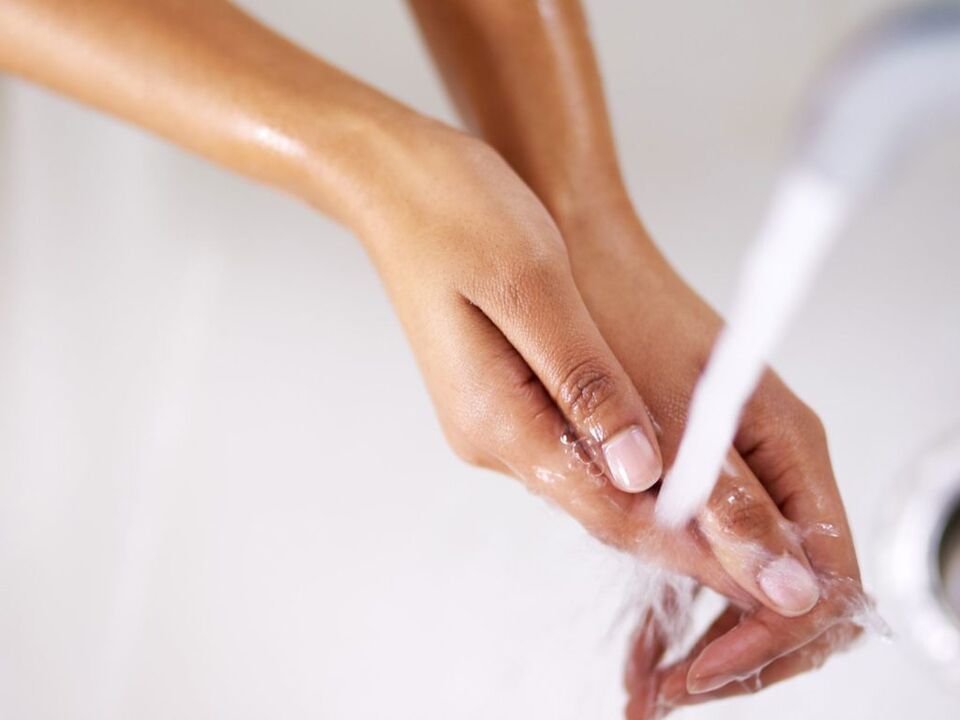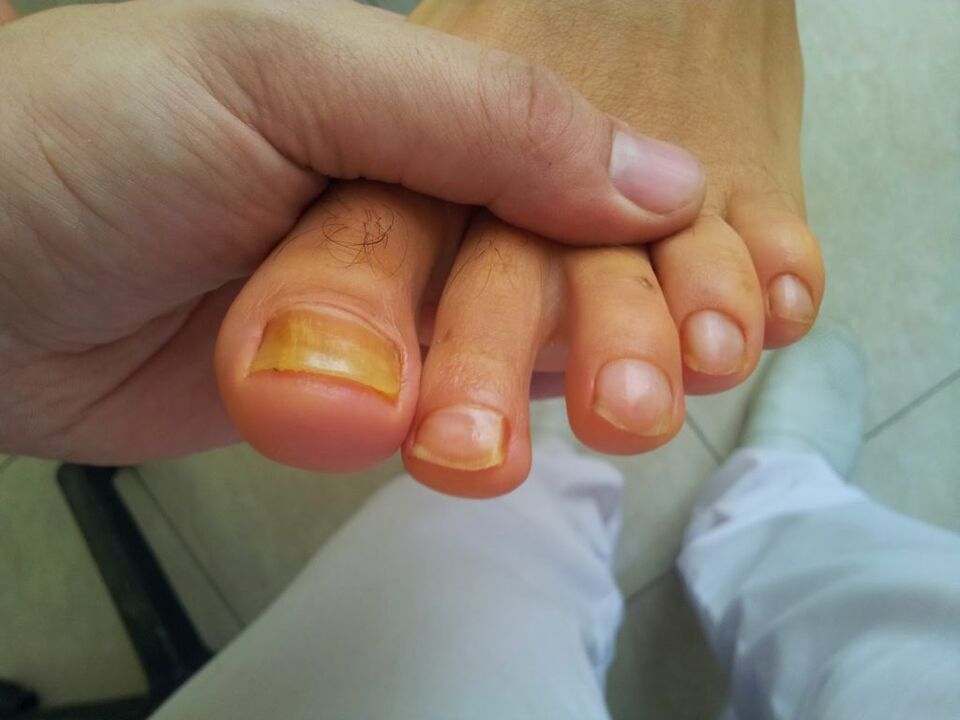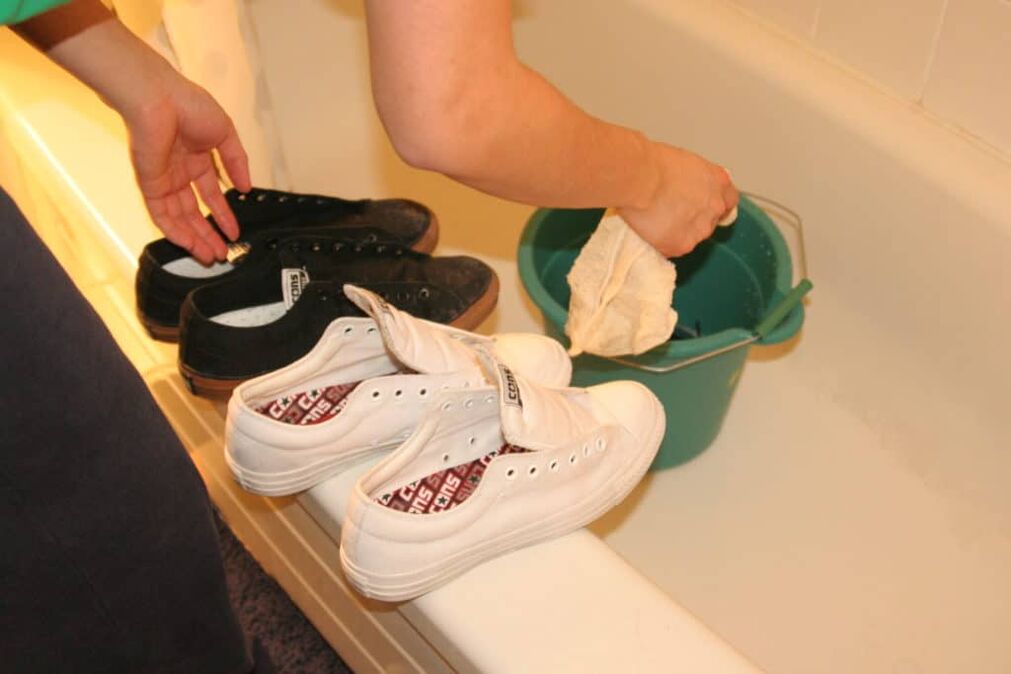The initial stage of the fungus is distinguished by the absence of severe symptoms. This is one of the reasons why many patients learn about their disease only after a period of time when the onychomycosis pathogens cause significant damage to healthy tissues. If a person is very careful about his health, then he will be able to recognize the first signs of infection. Their discovery is a serious reason to visit a doctor who deals with fungal pathologies.
Reasons for the development of onychomycosis

The initial stage of the fungus on the hands and feet does not bring much discomfort to a person. The first signs of the disease, which at this point are mild, are simply ignored by many infected. Because of this, they miss the opportunity to start early treatment of the disease and prevent the occurrence of serious complications.
There are many reasons that can cause a fungal infection to develop on the nails and adjacent areas of the skin. They create the optimal conditions for the successful growth of the pathogenic microflora. As a rule, onychomycosis is more susceptible in the elderly, as well as in people with weakened immune systems. Other adverse factors can also cause the development of the early stage of the disease:
- Neglect of personal hygiene rules.
- Damage to the skin in the area of the fingers or toes.
- Prolonged contact with moisture or chemicals that dry the skin.
- Regular use of tight clothes and shoes made of synthetic materials.
- Increased sweating during hot seasons.
- Chronic diseases that affect the state of immunity.
- Immune and endocrine diseases.
- Abuse of strong drugs.
- Climatic characteristics of the area that create ideal conditions for the reproduction of the causative agent of nail fungus.
If one of these negative factors affects the human body, it should consider preventing the development of onychomycosis. Otherwise, it will be difficult for him to avoid the fungal infection.
Avoid tight and uncomfortable shoes. As the fungus loves to "settle" in small cracks. Even the slightest damage to the plaque or the skin of the nails "pulls". Violation of the blood supply to the fingers is also dangerous. The cells then receive less useful nutrients and become easy prey for pathogens. So be careful with your shoes.
Comfortable orthopedic shoes are the key not only to healthy toenails and toes, but also save flat feet, calluses, calluses, calluses, make walking easier and correct existing disorders in the early stages. Daily use of such shoes offers comfort and not torture when walking. In addition, modern orthopedic shoes have a great design and maintain a modern style.
What does nail fungus look like in its early stages?
Nail fungus can bother absolutely anyone. In order to detect it in time, it is necessary to know what conditions characterize the initial stage of disease development.
Early signs of infection are felt from the first day of infection. However, they are poorly expressed, so few people pay attention to them. A person should be careful if, after visiting a public place with a high level of humidity, the color of the nail plates changes and itching occurs in the area of the toes. These are the first symptoms of onychomycosis. If the nails are healthy, then the infection will not be able to penetrate into their deeper layers. Only damaged slabs are subject to such an attack.
In the hands
Everyone needs to know what nail fungus looks like at an early stage. This information will help him in time to assess the disease in himself or in people around him.
Fungal infection of the hands in most cases is detected in women. However, members of the stronger sex are also susceptible to such an infection. The disease is recognized by such symptoms that appear first after infection:
- Darkening of the surface of the nail plate.
- The formation of spots on the nails.
- Change the color of the nail to yellow, gray or brown.
- Crushing of the nail plate near the edges.
- Detachment and fragility.
- Exfoliation of the skin near the nail.
Some patients develop signs of swelling near the nails. Although in the early stages of the disease, such a symptom usually does not appear.
By foot

Recognizing a fungal infection of the toenails helps with a number of signs that are characteristic of this condition:
- Yellowing of the nail on the top or side.
- Thickening of the nail plate.
- Nail discoloration;
- Slight itching in the area of the toes.
- nail peeling;
- Unpleasant odor on the feet.
Lack of treatment at an early stage of the disease leads to its progression. Therefore, it is very important not to miss the best time to start a treatment course, which will help treat the infection and prevent it from spreading to healthy tissues.
Treatment
Toenail fungus is easily treatable if the patient is diagnosed at an early stage of development. In order not to start the disease, it is necessary to abandon self-medication. The patient will not be able to choose adequate treatment on their own, which will lead to a positive result. It is best to assign such tasks to qualified specialists involved in the diagnosis and treatment of onychomycosis.
Topical preparations
The fungus on the hands, as well as on the lower extremities, can be eliminated with topical medications. The initial stage of the disease involves the use of such drugs that do not have a significant effect on the patient's body, but act directly on the lesions.
Comprehensive treatment of onychomycosis in the early stages of development necessarily involves the use of topical medication.
The external agent should be used according to the instructions of the treating physician, as well as the instructions for its use. Adherence to this rule will increase the effectiveness of the treatment course and avoid possible side effects.
According to the standard scheme, it is required to apply a topical preparation to the nail plate, which is infected with a fungus, 1-2 times a day with a thin layer. If special varnishes are used, then they are applied no more than once a week.
Systemic therapy
At the first sign of onychomycosis, you should consult a doctor. Toenail fungus can not always be treated with a topical medicine. Therefore, in addition, dermatologists prescribe a systemic drug that acts on the causative agent of the disease through the human body.
Oral medicines that have antifungal activity can only be taken according to the instructions of the specialist. This is because they have a long list of contraindications and side effects. The course of treatment for each patient is selected separately. It usually lasts about 4 months. If measures were taken in the early stages of onychomycosis, then this period is reduced.
The use of systemic medications is recommended if topical treatments do not stop the disease from developing.
Laser treatment and ozone therapy
It is possible to treat a fungal infection on the nail plates using material procedures. Laser and ozone therapy is used for these purposes. They are prescribed in the early and advanced stages of the development of the pathological process, if the traditional methods of treatment do not bring the desired result.
Laser treatment to fight nail fungus has many advantages:
- Obtaining a guaranteed recovery result in 99% of cases.
- No pain or discomfort during the procedure.
- No adverse effects on internal organs.
- Complete destruction of the fungus.
- Improvement of the general condition of the infected area after the first procedure.
- Restoration of the nail plate 30 days after the treatment.
Nail fungus on the hands or lower extremities also helps in the treatment of ozone therapy. The initial stage of onychomycosis is well suited for such a treatment.
Ozone has antiseptic action. Because of this, doctors use it to treat fungal infections of the nails. When ozone enters the body, it is transported to various parts of the body through the blood. After that, a fight is given with the causative agent of the disease, in which he loses in most cases.
Ozone therapy is completely painless. Its duration is limited to 30 minutes. During treatment, only the infected area is affected. The skin around the plaque is not affected.
Ozone, as well as laser treatment, is prescribed by the treating physician after the patient has passed all the necessary examinations and studies. Based on their results, the expert draws conclusions about the appropriateness of using such therapeutic procedures that help speed up recovery.
Folk methods
The treating physician may recommend the use of non-traditional methods of treatment along with medications. It is good to carry out such a treatment at an early stage of the development of the pathological process. Then it will be more useful. The treatment of onychomycosis can be carried out with such folk remedies:
- Iodine. They need to periodically treat the infected nail. It is desirable to carry out the procedure 2 times a day to stop the growth of pathogenic microflora on its surface. The antiseptic agent not only fights fungi, but also dries the nail plate. After a week of such treatment, it is recommended to take a break for 2-3 days.
- Garlic. This is a natural disinfectant that treats the active reproduction of pathogens. A fresh clove of garlic should be rubbed, after which this porridge is applied to the problem area. It is recommended to leave it overnight, securing the mass with a bandage.
- Celandine. With onychomycosis, the juice of this plant is useful. It is recommended to lubricate the areas infected with infectious disease in the upper or lower extremities with a fresh product. Before starting the procedure, it is necessary to perform an allergy test on this drug to avoid the development of side effects.
- Onion. It is effective against a fungal infection caused by a yeast-like pathogen. Fresh vegetables should be peeled and grated on a medium grater. After mixing the onion mass with a small portion of natural honey. The final product should be applied to sore nails for 2-3 hours. If you do this procedure several times a day, you can quickly achieve an improvement in the patient's general condition.
- Soda. Used in the preparation of thermal baths. It must be dissolved in hot or warm water. For 2, 5 liters of fluid, you need to take 1 tbsp. large. soda. It is also recommended to add a portion of liquid soap to the solution. This bath can be done daily for 15 minutes.
Folk remedies work only in the treatment of the initial stage of onychomycosis. In more advanced cases they do not bring much result. But even if the disease has just started, there is no guarantee that alternative medicine will help you get rid of it completely. It is best to use its methods in conjunction with medications to be sure of the effectiveness of the treatment.
Disinfection and other rules during the treatment period

The doctor will tell the patient in detail how to act in the early stages of the disease and will advise what the foot fungus looks like at an early stage.
In order for the treatment prescribed by the doctor to be effective, the patient must also follow special rules:
- It is necessary to disinfect the everyday socks and shoes that a person who has been infected with the fungus has come in contact with.
- It is necessary to boil the patient's towels and bed linen at a high temperature.
- It is necessary to thoroughly clean the bathroom after the patient's bath.
Boiling is strongly recommended to disinfect all acceptable objects and things that a person with onychomycosis has interacted with. You should also regularly wipe your shoes with special antiseptic and antifungal solutions.
Prevention of onychomycosis
Onychomycosis prevention should be done by every person who is at risk of contracting this disease. This measure will allow him to avoid wasting unnecessary money and time on medical procedures.
To avoid onychomycosis, you must:
- Avoid wearing other people's clothes and shoes. If this is necessary, then they should first be treated carefully with an antifungal and antiseptic agent.
- In public places, for example, a sauna or a swimming pool, you should use disposable slippers.
- Use only your own manicure tools.
If a person has been able to cure onychomycosis and further take preventive measures, then the chance of encountering the fungus again will be only 8%.





























